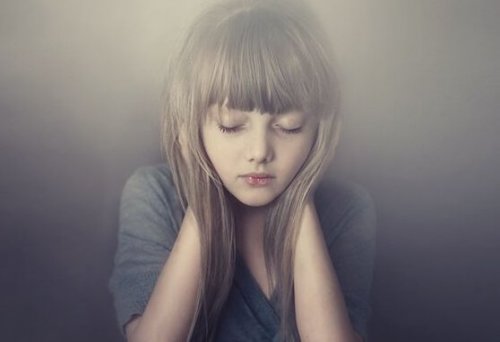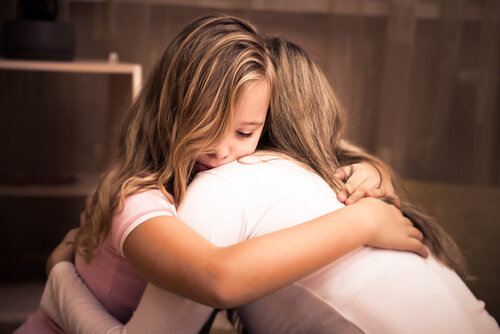Children Need Emotional Expression to Grow

“Don’t cry,” “Big kids are tough,” or “You have to be brave” are very common expressions adults use to comfort upset kids. It may seem like they work with some kids, at least in the short term. In the long term, however, they encourage kids to keep their feelings inside. That silence can have serious implications for their psychological and social development. Children need to engage in emotional expression.
Ignoring or denying children’s feelings is dangerous behavior. Consequently, it’s a good idea to avoid it if you want them to have good emotional health. It can also affect the positive or negative development of their relationships with other people. Just because they are small doesn’t mean their thoughts and emotions aren’t important. In fact, the opposite is more often true.
The truth is that their world is just as important as ours, and so are their feelings and perceptions. Our job is to support them as they get to know themselves. Let’s dig deeper into the beautiful job of teaching children about emotional expression and understanding their feelings.
The danger of repressing children’s emotional expression
Anger, sadness, or irritation are natural responses to children have to different situations. It might be because they don’t understand what is happening, or because they didn’t get what they wanted. Or, it’s just a tantrum. Whatever the reason, these emotions carry a message that says more than simply “I’m upset.” Our job is to understand that message.
If you reject a child’s negative emotional expression, you are teaching them to drown in their distress.
The right thing to do is interpret our children’s tears or anger and figure out what is wrong. If instead, we reject their emotions or don’t pay enough attention to them, we are only contributing to their negative emotions. In addition, we will be rejecting their identity. We are demanding a behavior that is convenient for us but is based on fear and emotional rejection.

If we repress our children’s emotions, they will become adults who cannot manage emotional language.That will be true for themselves and in their relationships with others, and will negatively affect their well-being. It will also limit their development of emotional intelligence. As psychologist Daniel Goleman says, knowledge of oneself and one’s own feelings is the cornerstone of emotional health. It is the foundation upon which personal growth sits.
Children’s emotional expression
We don’t have a lot of practice in teaching children to identify, express, and release their emotions. That is especially true when we talk about negative emotions like anger, irritation, or sadness. In fact, we believe that when children express these types of emotions it is because they are rude, uneducated, or aggressive. If we don’t teach them to connect with their emotional selves, they will never learn to understand themselves. As a result, they will never be able to manage their feelings.
If we want to raise emotionally intelligent and healthy children we have to start by letting them express their emotions. If we don’t, they will become more and more upset, until they express themselves in another way. They become prisoners of their emotions.
Expressing irritation or sadness brings relief and healing. It also helps us to keep moving forward and to understand ourselves. That’s why it’s so important. Also, if children learn proper emotional expression from a young age, they will become emotionally healthy adults. Investing in an emotional education for our little ones is an investment in the future of adults. We shouldn’t forget that.
It is important to communicate to children that all emotions are necessary.
How can we help children to express their emotions?
There are many ways for children to express how they feel, and channel their negative energy. These range from tears, to the process of identifying their emotions step by step.
The most important thing is to be aware that this is a necessary process for them. Never respond with anger, criticism, or threats. We should never lose control. We have to be their support in difficult times because they can’t take care of their problems on their own. That is especially true in the first few years of life. Children need to be in a calm environment, not with people that feed their anger.
Our attitude with children has to start from a place of love, listening, and empathy. That way, we can help them figure out what is causing their emotions, and how they can release them. Also, this kind of process will help them with their ability to regulate their emotions.
To teach children to understand what emotions they are feeling, we can teach them about the facial expressions, body movements, and tone of voice of each emotion.

One thing to avoid is to try to reason with children when they are angry or overwhelmed. We can suggest that they express how they feel, but waiting a few minutes usually helps them calm down.
That is the best moment for a good dialogue. We can encourage them to express everything they feel and need to feel better. Also, it’s important that we make them understand that when they express themselves, they have the opportunity to think and act in an appropriate way. The rule of thumb is not to offend or hurt anyone else.
The stoplight technique
One popular technique to teach children about emotional expression is the stoplight technique. The goal is to get children to associate the colors of a stoplight with their emotions and behavior. To do that, draw a stoplight and explain the following:
- Red light. We associate this color with stopping. So, when you feel angry, nervous, or you want to yell or fight, remember that the red light goes on and you have to stop. It’s as if you were the driver of a car and you stop at a traffic light. The message is “Stop! Calm down, and think.”
- Yellow light. This color means stop and think to figure out what the problem is, and what you are feeling. You can tell the children that when the light is yellow, drivers stop, think, look for solutions, and get ready to go. In this case, you would say: Think of solutions and consequences.
- Green Light. This color means that you can continue. Choose the best solution, and make it happen. The message that helps children in these cases would be: Go and use the best solution.
Another technique that tends to work with upset children is to ask them to draw their anger. Then, talk about everything they need. Lastly, have them rip up the drawing. That is a symbolic way to get rid of their anger after their message was communicated. They can also count to ten, spend a few moments alone, or breathe deeply. Later, reflect together on what made them feel that way. Talk about how they can channel their feelings, and how to solve their problems. The last part will encourage awareness and emotional expression and responsibility.

As we can see, children can express and vent their negative emotions. What usually happens is that they don’t know how to do it. Our job is to help them to express them with a positive emotional education, based on understanding and love.
This text is provided for informational purposes only and does not replace consultation with a professional. If in doubt, consult your specialist.








